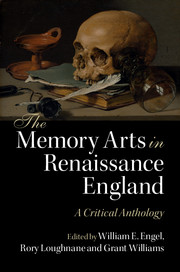Book contents
- Frontmatter
- Dedication
- Contents
- List of figures
- Acknowledgements
- A note on abbreviations
- Introduction
- PART I The art of memory
- PART II Rhetoric and poetics
- PART III Education and science
- PART IV History and philosophy
- PART V Religion and devotion
- Introduction to Part V
- V.1 Thomas More, A Treatise (Unfinished) upon these Words of Holy Scripture (1522)
- V.2 John Foxe, Acts and Monuments (1563)
- V.3 Thomas Playfere, The Pathway to Perfection (1593)
- V.4 Joseph Hall, selected works
- V.5 Richard Day, A Book of Christian Prayers (1608)
- V.6 Daniel Featley, ‘Four Rows of Precious Stones’ (1610)
- V.7 Lewis Bayly, The Practice of Piety (1613)
- V.8 John Donne, ‘Sermon, preached at Lincoln's Inn’ (1649)
- V.9 Stephen Jerome, A Minister's Mite (1650)
- V.10 E.M., Ashrea (1665)
- PART VI Literature
- Index
- References
V.6 - Daniel Featley, ‘Four Rows of Precious Stones’ (1610)
from PART V - Religion and devotion
Published online by Cambridge University Press: 05 August 2016
- Frontmatter
- Dedication
- Contents
- List of figures
- Acknowledgements
- A note on abbreviations
- Introduction
- PART I The art of memory
- PART II Rhetoric and poetics
- PART III Education and science
- PART IV History and philosophy
- PART V Religion and devotion
- Introduction to Part V
- V.1 Thomas More, A Treatise (Unfinished) upon these Words of Holy Scripture (1522)
- V.2 John Foxe, Acts and Monuments (1563)
- V.3 Thomas Playfere, The Pathway to Perfection (1593)
- V.4 Joseph Hall, selected works
- V.5 Richard Day, A Book of Christian Prayers (1608)
- V.6 Daniel Featley, ‘Four Rows of Precious Stones’ (1610)
- V.7 Lewis Bayly, The Practice of Piety (1613)
- V.8 John Donne, ‘Sermon, preached at Lincoln's Inn’ (1649)
- V.9 Stephen Jerome, A Minister's Mite (1650)
- V.10 E.M., Ashrea (1665)
- PART VI Literature
- Index
- References
Summary
About the author
Daniel Featley (1582–1645) was in the ‘First Oxford Company’ overseeing the later books of the Old Testament in the King James Bible. A chaplain to Charles I, he published Ancilla pietatis (in its sixth edition by 1639), from which the king derived solace during his time of extreme troubles.
About the text
This collection of seventy sermons reflects the highlights of Featley's career; twenty-one of the sermons were delivered in Paris when he was chaplain to the English ambassador. In 1610 he preached ‘Four Rows of Precious Stones’ at St Mary's Church, Oxford. Consistent with the effective use of an artificial memory system, he concludes by revisiting the main background image of Aaron's breastplate (with its twelve lapidary places, encoded mnemonics assigned to each, linked biblical narratives and corresponding moral injunctions), so as to provide an itinerary for future spiritual guidance.
The arts of memory
The background image of Aaron's breastplate is Featley's exegetical point of departure: ‘And the stones shall be with the names of the children of Israel, twelve, according to their names’ (Exod. 28:15). He dwells on the arrangement of the twelve precious stones worn by ancient Hebrew priests, each serving as a rich ‘place of invention’ from which he weaves an intricate chain of intertextual readings of the Old and New Testaments. Taking each stone as a mnemonic place in its own right with corresponding images, he rehearses the various typological interpretations that others have ascribed to Aaron's breastplate: ‘Saint Paul in the Epistle to the Hebrews proveth manifestly Aaron to be a type of Christ, his actions of Christ's passion’ (p. 533); and Saint Jerome used the four rows to fix in memory the four cardinal virtues. Following a catalogue of the ‘mystery hid in the numbers’ (including the beasts in Revelation, the Evangelists and the Church hierarchy), Featley ends with an appeal for religious and personal reformation.
Textual notes
Daniel Featley, Clavis Mystica, A Key Opening Divers Difficult and Mysterious Texts of Holy Scripture (London, 1636), pp. 501, 505–6, 512, 532–3, 536.
- Type
- Chapter
- Information
- The Memory Arts in Renaissance EnglandA Critical Anthology, pp. 254 - 256Publisher: Cambridge University PressPrint publication year: 2016



